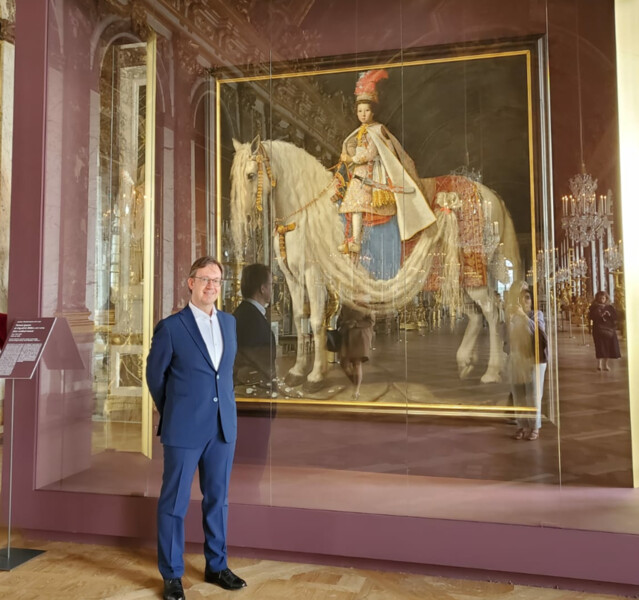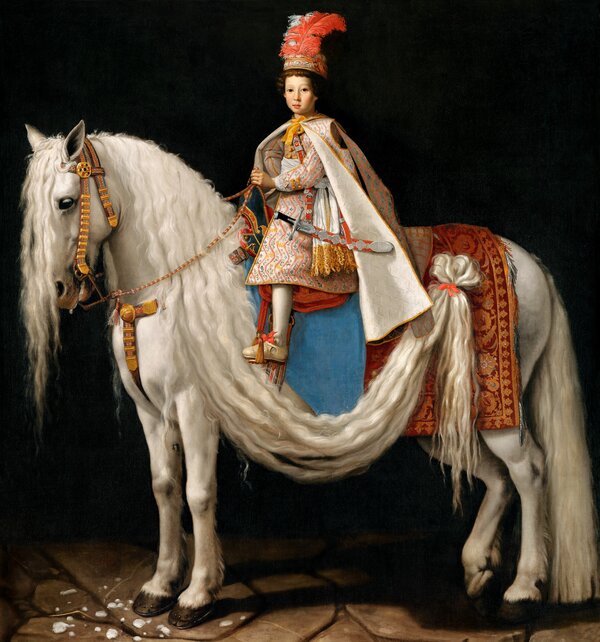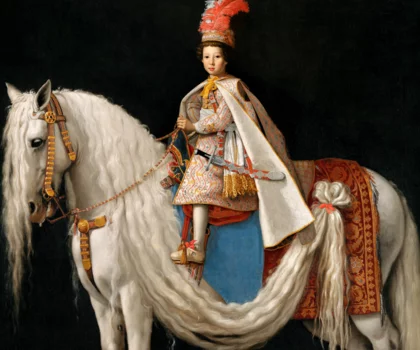Interview with Gianluca Tormen – discoverer of the equestrian portrait of Leopold Medici from Konopiště Castle

In the state castle of Konopiště hangs a painting recently identified by the Italian art historian Gianluca Tormen as an important work by the Flemish painter Justus Sustermans. The equestrian portrait of Leopold de' Medici is now the main attraction of the exhibition Horse in Majesty, which is being held at the Palace of Versailles on the occasion of this year's Olympic Games in Paris. The painting will be on display until 3 November. We spoke to its discoverer, Gianluca Tormen, about its author, history and significance.
How did you get to the d´Este collection at Konopiště Castle?
I think it is essential to make a premise: the Este were the Dukes of a small state in the north of Italy with the capital in Modena (16th-19th century). Most of the masterpieces in the so-called ‘Este collection’ now in Konopiste were inherited from an earlier collection, belonged to the Paduan family of the Marquis Obizzi, with whom the Este family had friendly and kinship relations: it is therefore more correct today to speak about the ‘Obizzi-Este’ collection. It was already known from some publications that the Obizzi collection - once the family had died out - had all passed to the Este family, and later to the Este branch of the Habsburg in Wien. The last owner was the unfortunate Archduke Franz Ferdinand of Austria, who, however, before being assassinated in Sarajevo, moved part of the Obizzi-Este collection to his castle in Konopiste, at the end of the XIX century. And this is where my research led me, starting from the Obizzi collection of masterpieces.
I suppose you saw the painting first from photographs, what was it like to see the painting "live"? (when did you first see the painting).
I actually only knew the painting from a small picture reproduced in a guidebook of Konopiste Castle. I had the opportunity to admire this wonderful painting in person during my first visit to the Bohemian castle in the company of two art historians in Prague to whose friendship I owe much: Jaroslav Horacek and Petr Pribyl. In their company, some years ago, I visited the castle because they were helping me with my research on the Obizzi collection. They organised the visit to Konopiste and so I was able to see the rooms and admire the masterpiece painted by Sustermans. Needless to say, it was an emotion for me to stand in front of that equestrian portrait, its beauty literally hypnotised me, as it still did when I saw it in the Palace of Versailles.
The painting was long identified as the equestrian portrait of the Polish King Vasa... was it also attributed to a specific artist?
I do not recall reading in the guide just mentioned, nor in the caption of the painting in the castle, that reference was made to the name of any painter. It was also for this reason that I decided to study that painting further in an attempt to attribute it to an artist. The work was completely unknown at the time, so it was not even possible I believe for anyone to make any attribution.
How did you identify the painting? What was the path that led to it? What was the main argument that the portrait couldn't have been Vasa, the King of Poland?
As I wrote, studying the Obizzi collection I traced, not long after seeing the great painting, a will of Roberto degli Obizzi (1566-1647) listing several paintings from his collection kept in Ferrara and in a residence not far from Modena, called “La Quiete”. One painting, in particular, described the equestrian portrait of Konopiste verbatim, saying that the subject was the ‘Prince Leopold de’ Medici on horseback at the age of seven, dressed in the Polish manner'. My memory then immediately went to that work in the Bohemian castle: making further comparisons with other portraits of Leopold in the Uffizi Gallery in Florence, I was able to confirm that the subject was indeed that one.
Sustermans was originally a Flemish painter, from Antwerp (like Rubens or van Dyck), who made a name for himself at the court of the Medici family, What was Sustermans' relationship with this Italian family?
Justus Sustermans (in Italian Giusto Suttermans, or just Monsù Giusto) was in fact a native of Antwerp and between the end of 1620 and the beginning of the following year he began to appear in documents relating to the court of the Grand Dukes of Florence, where he had arrived in the service of some very skilled tapestry weavers. Sustermans soon started making paintings and became the official court painter until his death in 1681.
… and Sustermans relationship to Leopoldo de'Medici? There is another Sustermans´ portrait of Leopoldo in his older age…
As court painter to the Medici, Sustermans obviously also got to know Leopold (1617-1675), last son of the Grand Duke Cosimo II and the Archduchess Maria Magdalena of Austria. As an adult, Leopold was initiated into an ecclesiastical career, becoming a cardinal. Sustermans made several portraits of him over the years, also in priestly robes, one in particular is preserved in the Kunsthistorisches Museum in Vienna (also from the Obizzi-Este collection).
In the equestrian portrait Leopoldo de´Medici is dressed festively, do we know for what occasion Sustermans painted the work? Why did he depict Leopoldo on horseback? Is there any known background?
I believe that the painting was commissioned to the painter by the aforementioned Roberto degli Obizzi, senior horseman of the Medici. Roberto was probably also charged with teaching little Leopold the art of riding, which is perhaps why he had him portrayed riding that magnificent horse. The animal also seems to have been a gift from the Duke of Lorraine to the child, or to his father. We know that on various occasions of feasts or outings, Cosimo II's children were dressed in those curious clothes, gifts that came to the Medici princes from their aunt Constanza Renata (sister of Maria Magdalena), then Queen of Poland.
What information do we have about the unusually rich horse harness, the saddle is not visible, only the saddle pad and especially the mane which is attached to the back of the saddle pad. Leopold's upper coat is open to the viewer, held by a sabre. Do these details have a symbolic level?
The horse's harness - as you rightly say - is very rich, and scholars in Florence have been trying to find out if any trace of it can be found in museum deposits. It is probable that the choice of harness was due to the wishes of the commissioner, Roberto Obizzi, who wanted to decorate this beautiful horse, whose main peculiarity is precisely that very long mane that makes him unique to our eyes. A horse so harnessed was perhaps meant to be used for parade ceremonies. Even the choice of portraying the young Leopold in Polish clothing must have served to make the painting more spectacular: the coat has been deliberately opened at the front to highlight the sabre whose scabbard is decorated with silver chiselling. The sabre, moreover, also appears in another portrait of Leopold, also by Sustermans, which is preserved in the Uffizi, where, however, the little prince is standing and of a younger age.
Did you also focus on the iconography of the work? I'm curious about the significance of the blue fabric that emerges from under the saddle. And which apparently influenced the main background colour of the official poster for the Cheval en majesté exhibition... as well as the white "spots " in front of the horse on the pavement.
I have obviously tried to study the painting in its general iconography, and dwell on as many details as possible. I have also concentrated on reflecting on the significance of the light blue under saddle that really stands out in the work. I believe that this was an indirect clue to underline the commissioning of the painting by Obizzi. In fact, the light blue drape is close to the white mane of the animal: the noble coat-of-arms of the Obizzi family includes a shield with alternating bands of light blue and silver (a colour, the latter, which in heraldic symbolism was translated into white). The juxtaposition of the two colours was therefore perhaps an indirect reference to those on the family coat of arms, thus linking the Obizzi name to that of the Medici. The white spots on the floor are nothing more than the amount of foam produced by the horse. We know that a horse foams for basically two reasons: either because it does not tolerate the bite in its mouth, or for the exact opposite reason, because it is fine and manifests it with a lot of foam.
Where did the painting originally hang? What was the journey of the painting to the d´Este Collection, or to Konopiště?
The portrait of Leopold de Medici on horseback, as mentioned, was located in Roberto degli Obizzi's villa known as ‘La Quiete’, not far from Modena. We still do not know when, but the painting was later transferred to the Catajo Castle near Padua, perhaps at the end of the 18th or beginning of the 19th century. There it remained until Archduke Franz Ferdinand's decision to take it to Vienna and from there to its final location in Konopiste.
Is the equestrian portrait placed at Konopiště one of his top works? Is there any other equestrian portrait in his career?
It is difficult to say whether this portrait is Sustermans' absolute masterpiece; certainly it is limited to the works he produced in his youthful phase. But there is no doubt that it is generally one of his most successful and fascinating portraits. And it is equally true that there are no other equestrian portraits by the artist, at least to my knowledge, depicting other members of the Grand Ducal family of Tuscany, or of other dynasties.
Based on your identification, the equestrian portrait of Leopold today decorates the Hall of Mirrors at Versailles and is one of the main draws of the Cheval en majesté exhibition. Does the equestrian portrait bear contemporary comparison? Is it deservedly in its place?
The beauty of the painting, its formal perfection, the care in rendering the smallest details and above all the iconographic originality that sees a child riding a horse evidently also fascinated the curators of the Versailles exhibition. Their choice to display it in the most prestigious room of the palace I believe is the most explicit homage to the painting's value, as is the decision to reproduce it in the posters advertising the exhibition in Paris. It will also appear, apparently, on the cover of the catalogue.

